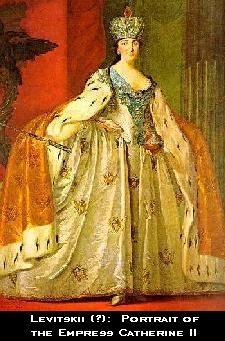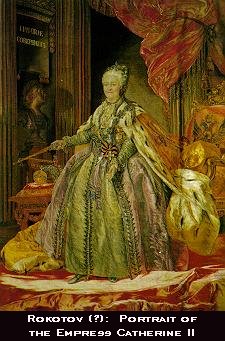
Oil on canvas, 154.5 x 122.5 cm. The Kalinin Regional Art Gallery.

Aleksei Petrovich Antropov (1716-1795) was one of the first and best known Russian eighteenth- century portrait painters. He was born, and died, in St. Petersburg. Antropov began his studies in 1732 at the Office of Buildings in St. Petersburg where he was tutored by Matveev and Caravacque. In 1739 he began his collaboration with another of the artists of the time, Vishniakov, famous for his lacquer factory. Together with Rotari, Antropov decorated the Anichkov Palace and the Opera . His work can also be found in other palaces in St. Petersburg and its suburbs, in Moscow, as well as in St. Andrew Cathedral in Kiev. When Antropov began to paint, his works reflected to a certain degree the parsuna tradition, but his more mature works show his departure from that tradition and his incorporation of the idiom of the Western portraiture of the time. His talent can be seen not only in the representation of Catherine II, but in his portraits of Peter III, A.M. Izmailova, and A.V. Buturlin, all from the Tretiakov Gallery. They are all outstanding for their directness, truthfulness, decorative splendor, and intense colors.
In the portrait of Catherine the Great, the Empress is depicted in a less formal pose -- instead of standing, she is seated on her throne. But this lesser formality is amply compensated by many attributes of the Empress' imperial status. In her right hand Catherine is holding a bejeweled scepter which she has just picked up from a red pillow decorated with gold embroidery and gold tassels. Two other attributes of royalty, a crown and an orb, rest on the pillow. The crown, made especially for the coronation, is the work of Jeremie Posier (Ieremiia Pos'ie) and consists of over 5000 diamonds (about 3000 carats) topped by an enormous 415-carat red spinel. The orb, made of solid gold, is enhanced by a band of diamonds and by a 47-carat sapphire. Antropov's artistic and technical ability is well attested by his attention to the details of the Empress's dress. Her narrow-waisted silken gown with golden double-headed eagles embroidered on its skirt is partially concealed by an ermine mantle made of four thousand ermine skins and brocade covered with similar embroidered black and red double-headed eagles. The double-headed eagle appears in the painting so many times -- in embroidery, on the throne, and in the ornamental treatment of the table -- that it may be called a leitmotif of the painting. Lace sleeves of the dress barely protrude from under the ermine. Antropov's gift of observation and his technical excellence allow him to notice and render delicate pearl bracelets and a ring on Catherine's finger, as well as a diamond tiara, diamond earrings, and a diamond necklace with the large order of St. Andrew the First Called. The artist's apparent predilection for various shades of red -- from the brilliant red of the pillow, through the red spots in the embroidered two-headed eagles and the Empress's heavily rouged cheeks, to the slightly subdued carmine on the back of the throne contributes to the overall "shimmering" and sumptuous effect of the portrait.
 Now
we can compare Antropov's work to two other portraits of Catherine, by
Levitskii(?) and by Rokotov(?). Unlike Antropov's portrait, both canvasses
show the Empress standing. Please note that the work attributed to Rokotov
is a tapestry, dated 1833 and based on Rokotov's original portrait. However,
the Hillwood Museum has a very similar oil portrait of the Empress attributed
to . . . Levitskii.
Now
we can compare Antropov's work to two other portraits of Catherine, by
Levitskii(?) and by Rokotov(?). Unlike Antropov's portrait, both canvasses
show the Empress standing. Please note that the work attributed to Rokotov
is a tapestry, dated 1833 and based on Rokotov's original portrait. However,
the Hillwood Museum has a very similar oil portrait of the Empress attributed
to . . . Levitskii.
Levitskii shows the Empress in the same royal garb as Antropov. On
both portraits the Empress seems to be quite young and she is still wearing
her hair in a long braid. It is quite probable that both paintings were
executed shortly after Catherine's successful coup d'etat and her ascension
to the Russian throne in 1762, when she was only 33. Levitskii's portrait
is dominated by the central majestic figure of the Empress and by the huge
double-headed eagle behind her. Our eyes move to the eagle, following the
direction of the Empress' scepter, perhaps a symbolic indication of her
dedication to the well-being of Russia. As far as the reproductions allow
us to see, the scepter does not yet have the spectacular Orlov diamond
mounted on its top. The 196-carat diamond was presented to the Empress
in 1773; this allows us to date both paintings to between 1762 and 1773.
 The
second portrait is hypothetically attributed to Rokotov. Even though the
artist painted one of the first formal portraits of Catherine, the work
was later copied by Rokotov himself and by other painters. In this variant
of Rokotov's painting the scepter appears to be crowned with the Orlov
diamond and the Empress' gray hair indicates her advanced age. Since she
died in 1796, the updated version of the portrait was probably painted
in the late 1780s. Perhaps the symbolic inscription in the left upper corner
-- "Finishes what was begun" (nachatoe sovershaet) -- can give us an additional
clue as to the more precise date of the portrait. However, it is also possible
that the words relate to Catherine's belief that she continued and finished
the reforming of Russia started by Peter the Great; perhaps the statue
under the inscription portrays the reformer. This idea would connect Rokotov's
portrait with the famous statue of Peter the Great by Falconet, which bears
the inscription "To Peter I--Catherine II" (Petru pervomu Ekaterina vtoraia).
The
second portrait is hypothetically attributed to Rokotov. Even though the
artist painted one of the first formal portraits of Catherine, the work
was later copied by Rokotov himself and by other painters. In this variant
of Rokotov's painting the scepter appears to be crowned with the Orlov
diamond and the Empress' gray hair indicates her advanced age. Since she
died in 1796, the updated version of the portrait was probably painted
in the late 1780s. Perhaps the symbolic inscription in the left upper corner
-- "Finishes what was begun" (nachatoe sovershaet) -- can give us an additional
clue as to the more precise date of the portrait. However, it is also possible
that the words relate to Catherine's belief that she continued and finished
the reforming of Russia started by Peter the Great; perhaps the statue
under the inscription portrays the reformer. This idea would connect Rokotov's
portrait with the famous statue of Peter the Great by Falconet, which bears
the inscription "To Peter I--Catherine II" (Petru pervomu Ekaterina vtoraia).
The comparison of these three portraits reveals some amazing similarities in details (notice the presence of the regalia, the ermine mantle, and the double-headed eagle in all three paintings). At the same time, the portraits differ in "formality," Levitskii's work being the most formal and the most "royal," reminiscent of the royal portraits of Hyacinthe Rigaud. Antropov's portrait is the most decorative and whimsical, while Rokotov's work contains an interesting inscription linking Catherine to her idol Peter the Great. [S.H. and A.B.]
[Sources: Massie, Treasures of the Czars, Andrews, The Great Soviet Encyclopedia].
